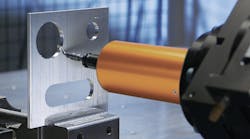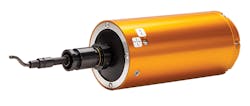The tedious twisting and turning motion of manual finishing tasks can leave operators with debilitating aches, pains, and fatigue. That’s bad news for manufacturing operations and machine shops that are dealing with an aging workforce and a lack of skilled operators to replace retirees. ATI Industrial Automation, a provider of robotic accessories and robot arm tooling, is addressing the need for safer, more efficient finishing capabilities to be used with automated solutions. The company’s latest offering is a robotic tool called the Compliant Deburring Blade.
It features a pneumatically controlled, articulated design that gives users the ability to adjust the contact force to accommodate specific applications by changing the air pressure. It’s suitable for light to medium deburring, chamfering and scraping operations on materials such as plastic, aluminum, steel, and brass. The deburring tool reduces robotic programming time and maintains constant force where surface irregularities are present, according to ATI.
NED recently caught up with ATI CEO Robert Little to discuss how the new tool works and why it is critical for manufacturers to integrate automated finishing solutions into their operations.
Why do you think it’s important to place a greater emphasis on automating manual finishing processes, such as deburring, in today’s industrial environment?
A handheld deburring blade is still the most commonly used tool in manufacturing for deburring sheet metal, plastics, holes, etc. It’s typically done manually, which makes using a hand tool with a blade on the end slightly dangerous. In addition, it's a tiresome, repetitive motion that can easily lead to conditions, such as carpal tunnel syndrome. We find that typically people who come into facilities to do deburring by hand don't last very long. And because of that, the quality sometimes is not there.
Can you please explain the term “compliant” and why it’s significant?
Robots are stiff objects that are not inherently compliant. They are great at following an exact path, but in a material removal application, the robot would struggle to produce a consistent finish. It would cut too hard, too soft, it would miss spots. The robot, the station orienting and staging the parts, and the workpieces themselves each have differing tolerance and accuracy ranges. This means that each part of the process is aiming for a slightly variable target. For example, injection molding parts can come out of the machine with as much as 2 to3 mm difference in size and still be “good” parts. How do you accommodate for all of that variability within the process? Well, you need to have compliance. And that compliance has to be engineered appropriately to produce consistent cutting force so the robot and tool return to a repeatable center point. The compliant deburring blade helps users make sure that the cut produces the desired result.
What is the Compliant Deburring Blade, and how does it help improve efficiencies and reduce operator fatigue?
We asked our engineers to investigate how the process was being done by hand; they studied it and then designed a compliant deburring tool that mimics the variability of the manual force being used. It’s compliant radially and axially. They also designed it with an optional automatic blade-changing tool to enable quick, hands-free, changeover of cutting media. The Compliant Deburring Blade is compatible with a vast array of standard blades and can be used on a wide range of materials, including aluminum sheet metal, steel, iron, and composites.
How does this type of automated tooling help manufacturers compete in a global marketplace?
Let’s put it this way: the ability to make products close to your customer helps a lot. A U.S. company using robotic solutions can make up for a lack of manpower and therefore can more easily and affordably manufacture here. Outsourcing work to locations where labor is cheaper and more readily available increases lead time and transportation costs. Automation enables manufacturers to do the work here and eliminate long, transcontinental shipments.













